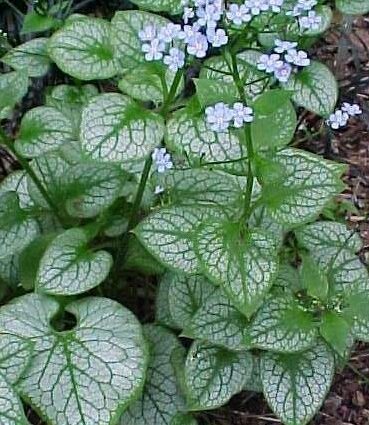Decorative and unpretentious brunner is very popular today. It can easily withstand cold temperatures down to -33 ° C, does not require special care and can grow in one place for many years. On garden plots, two types are most often found – large-leaved and Siberian.
Brunner, or forget-me-not, feels great on flower beds and lawns, along paths or along the perimeter of the reservoir. In a word, she feels good everywhere. When starting planting, take into account the plant variety and its preferences. The soil is selected poorly nutritious, otherwise the flower will increase the vegetative mass to the detriment of decorativeness.
Brunner’s flower looks like a forget-me-not
The Siberian form prefers shade and high humidity. She is most comfortable on the north side of the house or among the trees. In such conditions, foliage pleases the eye all summer.
The bush must be divided every five years. This will rejuvenate the plant and increase leaf growth.
Large-leaved variety grows both in the shade and in the sun. Loves wet soil and feels great near water bodies and streams. Both varieties prefer a temperate climate and, even in cold and humid summers, retain the density and decorativeness of their foliage.
A forget-me-not is planted in August or September. Spring transshipment of the plant is contraindicated. But if such a need arose, then transplant it with a large clod of earth and only in the evening or on a rainy day. The plantings are immediately watered and mulched with peat or sawdust to retain moisture.
Care for the forget-me-not is so simple that even novice gardeners can do it. It is with him that many lovers begin their passion for flowers. Once a young plant is planted in a suitable location, it doesn’t even need to be watered regularly.
The only thing that a forget-me-not is demanding for is the purity of the soil. The flower does not like the neighborhood of weeds, so it is carefully weeded. It is impossible to loosen the landings. The roots are very close to the surface and can be damaged.
Abundant irrigation is required only in dry summers or bushes growing in an open, sunny place
The plant is practically not affected by diseases and pests. In especially damp and cold years, brown spot or powdery mildew develops. In this case, the bush is treated with a fungicide. Of the pests, the whitefly or green aphid occasionally attacks. They are also fought with insecticide spraying.
Brunner is picky about feeding. Rather, she doesn’t need them. The plant is content with mulching and a one-time introduction of ash into the root circle. For the winter, the bushes are covered with spruce branches to keep the snow cover or covered with snow
Due to its unpretentiousness and excellent health, the forget-me-not is considered the best plant for wet and shady areas. And decorative foliage will decorate the most inconspicuous corner of the garden.










